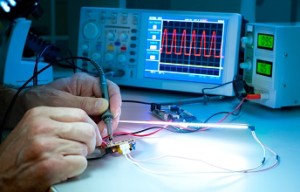What does an oscilloscope do?
An oscilloscope is an electronic test instrument that is used in a variety of fields. One of the most common uses for the oscilloscope is to test medical equipment. Medical oscilloscopes are usually called R&D oscilloscopes. Some oscilloscope uses include testing signals with high frequency ranges and collecting electromechanical measurements. They have the ability to measure digital signals i.e., TTL, ECL, logic levels, along with visual display of signal abnormalities. This type of instrument is generally considered a necessity for medical laboratories that assist in research and development procedures.
Another common use for this type of equipment in a laboratory is maintenance of laboratory equipment. The scope assists equipment operators in calibrating lab equipment and ensuring that it is functioning properly. Laboratory equipment doesn’t provide the most accurate results if all the internal components of the equipment aren’t operating at their optimum levels. Scopes help researchers determine whether their equipment is emitting the best frequencies and signals for their lab work.
What is the importance of an oscilloscope?
In the medical field especially, it is essential that your laboratory instruments are kept up to the latest quality standards. If they aren’t and readings prove to be inaccurate because your lab equipment wasn’t properly calibrated, then your laboratory could be subject to lawsuits and other negative legal actions and penalties. Therefore, ensuring that all your medical equipment is compliant with the latest industry quality put into place is of the utmost importance.
When oscilloscopes are used to calibrate your equipment, it is essential that the company that performed the calibration services gives you a detailed report containing the condition of the instrument that was calibrated, the work that was performed on the instrument, a report of the calibration, and a sticker to place on the equipment with the date that the services were rendered. Different types of equipment are required to be calibrated in different time intervals, so you always want to make sure that your lab equipment is calibrated within the time frame that it is supposed to be.
What are the different types of oscilloscopes?
There are many different types of oscilloscopes available on the market, some of which include digitizers, dual-trace, signal analyzers, digital storages and many others. The type of scope that needs to be used on your equipment can best be determined by the company performing the calibration services for you. Their professionals have the intricate skills and knowledge of various types of laboratory equipment to determine which scopes would best analyze your particular type of equipment.
Any time your laboratory equipment is malfunctioning, scopes can be used to troubleshoot the devices to determine just what’s wrong with them. A skilled technician can read the information output provided by the scope to determine exactly what failed in an electronic component. This aids greatly in repairing electronic devices like laboratory equipment by pinpointing specific problems with the equipment that would have otherwise been non-discoverable by the human senses. Scopes are arguably ones of the most useful tools in the medical laboratory industry.

